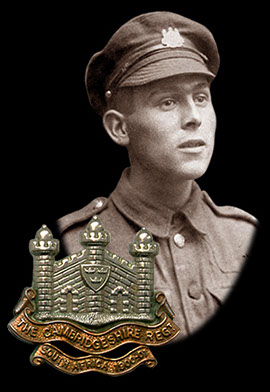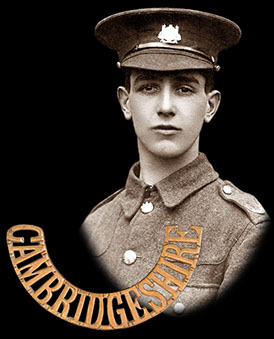
Who Were
The Cambs
The Cambs
at War
1/1st Btn 1914-1919
1914 - 1/1st Overview
1915 - 1/1st Overview
1915 - St Eloi
1915 - Fosse Wood
1916 - 1/1st Overview
1916 - The Schwaben
1916 - St Pierre Divion
1917 - 1/1st Overview
1917 - St Julien
Insignia, Medals & Books
Remembering The Cambs
Biographies
About Us &
This Site
Storm clouds over the Somme - February 1918 to 20th March 1918
At the end of January 1918 the 1/1st Cambridgeshires moved back into the line on the Somme, this time facing the formidable German defensive system known as the Hindenburg Line. It was here that the Germans had retreated in early 1917 to take up strongly fortified positions after the gruelling Somme campaign of 1916.
The Cambs Regt, now part of III Corps in the Fifth Army, relieved the 1st South African Brigade in the Gouzeaucourt sector, taking up a position on the left of the area. The village of Gouzeaucourt is 15km south-west of Cambrai and a similar distance north-east of Peronne.
Writing in the regimental history The Cambridgeshires, Lt-Col M C Clayton DSO, who at the time was a Major and about to leave the front to attend at Senior Officers Course in England, commented: Life was comparatively pleasant after Ypres, though casualties were frequent both in and behind the line.
He noted the increase in the number of German troops and ominous activity behind their lines, which all pointed to an early offensive by the Germans, who were bolstered by troops no longer required on the Eastern Front following the 1917 revolution in Russia, and were keen to strike a decisive blow before American troops arrived in large enough numbers to swing the balance in favour of the Allies. At the same time, the British were reducing the size of their infantry brigades from four battalions to three as shortages of men forced the army to disband some battalions, usually Kitchener New Army units rather than first-line territorial units (such as the 1/1st Cambs).
It was a time of regular patrols by the Cambridgeshires to find out enemy dispositions and this prompted retaliation from German artillery. Casualties on February 4th included 2nd Lt Henry Brodie Day, from Melbourn, near Royston. The former Cambridge County School pupil had enlisted as a private in the Suffolk Regiment in January 1916 and served on the Western Front before being commissioned. He had joined the 1/1st Cambridgeshires at the end of July 1917. He was killed by shellfire along with his batman, and is buried at Fins New British Cemetery, Sorel Le Grand. Also killed at this time were Pte William Day, from Newmarket, and Pte Arthur Gentle and L/Cpl Herbert Wilkinson, both from Cambridge. Two days later the battalion was relieved by the 1/1st Herts, which was being moved from 118th Brigade to 116th Brigade as part of the reduction in the size of brigades.
The Cambridgeshires returned to the left sub-section at Gouzeaucourt on February 10, relieving 1/6th Cheshires, and remaining there until February 18. During this period the Battalion’s dead included Pte Edwin Doggett, of Norwich, Pte Harry Nightingale, of Cambridge, and Pte William Green, of Coates. All the men killed in February are buried at either Fins New British Cemetery at Sorel Le Grand or Gourzeaucourt New British Cemetery, with the exception of Pte Walter Baxter, who is buried at Tincourt New British Cemetery. On February 16, 2nd Lt Alan William Dale, from Holborn, London, had been wounded and 2nd Lt Cyril Henry Taylor, from Haringay, was sent to England with sickness. Dale and Taylor had joined the 1/1st Btn at the front on December 7.
After four days the Battalion returned to the front line, remaining there until March 2, losing Pte Albert Chambers, of Kent, and Pte Oscar Tuck, of Cambridge.
The same pattern continued with another four days out of the front line, before returning on March 6, where the following day a gas shell fell among a working party of A Company with fatal consequences for a dozen men. They were Pte William Bailey (Cambridge), Pte Charles Brooker (London), Pte George Bullard (Norwich), L/’Cpl Robert Butler (Cambridge), Pte Albert Chappell (London), Pte Leonard Gray (Cambridge), Pte Thomas Marshall (Cambridge), Pte Robert Mayes (Stowmarket), Pte Walter Pointer (Sprowston), Pte Wallace Rolph (Cambridge), Pte Albert Sadler (Cambridge), with two more, Pte Robert Almond and Pte Albert Lovejoy (both from London) succumbing to gas poisoning the following day. These men are mostly buried in Fins New British Cemetery, with one at St Sever Cemetery Extension in Rouen and two at Tincourt.
Being relieved again on March 11, they moved by train to billets at Moislains, still on the Somme but 20 miles north-west of Saint Quintin and eight miles behind the lines, for rest as part of the Fifth Army’s reserve, but were placed on 12 hours’ notice of movement. As Clayton wrote in the battalion history: We knew the storm was gathering: when would it break, and on which part of the line?
They would soon find out and, between March 21-31, would be thrust into one of the darkest periods of the whole war when the enemy’s massive spring offensive pushed the Allied forces many miles back across the 1916 Somme battlefields.

Leonard Gray, DoW 7th March, photographed here in the summer of 1917 wearing black cloth over his second button in mourning for his brother Joe.

Joe Gray, brother of Leonard, KiA 21st September 1916.

This site went live on the 14th February 2015 to mark 100 years since the 1/1st Cambs went off to war.
WE WILL REMEMBER THEM
Email us: cambsregt@gmail.com
Copyright 2015, 2016, 2017, 2018, 2019 by Felix Jackson. The information and images on this site should not be reproduced without prior permission.